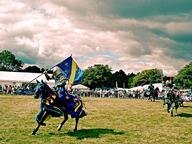Quiz Answer Key and Fun Facts
1. In the twelfth and thirteenth centuries, Italian merchants benefited economically from outfitting soldiers who were on their way to fight in what became a series of military campaigns. What was the collective term for this series of campaigns?
2. Which of the following statements best describes government in Italy in the twelfth and thirteenth centuries?
3. Prior to the Renaissance, Italian cities became the battlegrounds of wealthy nobles who carried out bloody feuds in order to maintain power. What are these feuds called?
4. It became common practice for a "capitano" to be hired by the Italian city-states to end the feuding and maintain order. Once order was restored, it was difficult to remove the "capitano" from power. He was likely to stay in power as what official?
5. Early in the fourteenth century, Italy was beset with famine. What caused the repeated crop failures?
6. The Great Famine of 1315-1317 led to a sharp decline in trade. What did trade guild members do to protect their businesses?
7. As a surge of trade was experienced in pre-Renaissance Italy, families who had the funds established banks and became very wealthy. The two largest Florentine banks, the Bardi and Peruzzi, however, collapsed when King Edward III of England refused to pay his debts. Which banking family, prominent in Renaissance Florence, was subsequently able to rise to power?
8. Just when pre-Renaissance Italians were thinking that life couldn't get worse, the Black Death began ravaging the countryside. This was the first time Europeans had suffered from the plague.
9. It is estimated that it took at least 150 years for Europe to regain the population lost during the years of the Black Death.
10. As if all the other problems weren't enough, two of Italy's city-states that played prominent roles during the Renaissance, were involved in an ongoing war before the Renaissance began. Which two cities were at war?
Source: Author
ponycargirl
This quiz was reviewed by FunTrivia editor
bloomsby before going online.
Any errors found in FunTrivia content are routinely corrected through our feedback system.

